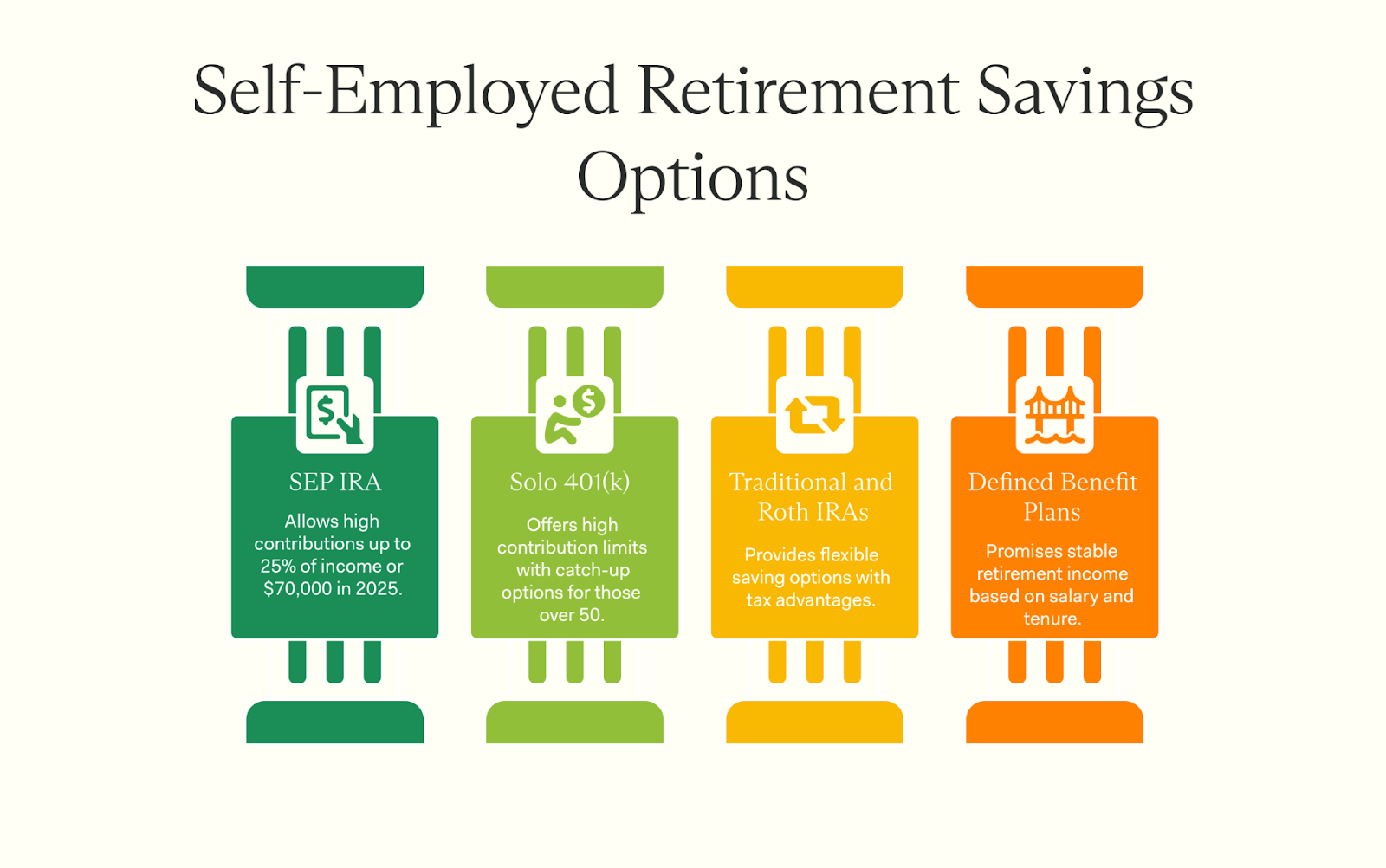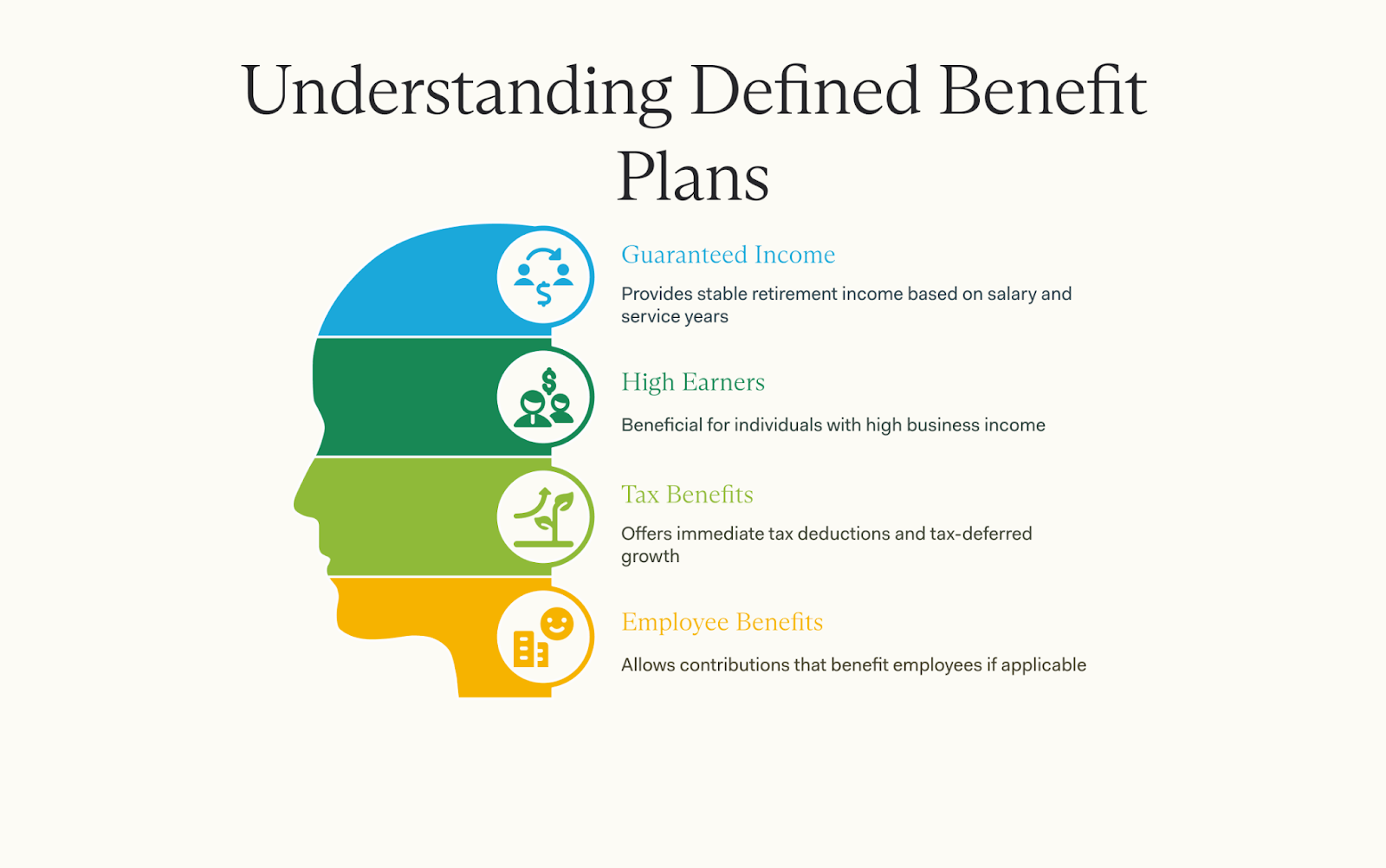Explore essential retirement options for self-employed individuals and find the plan that suits your needs. Read the article to make informed choices!
If you're self-employed, it's essential to take charge of your retirement savings. Without a company plan in place, you need to be proactive about building a financial cushion for your future.
The good news is there are several retirement options available that offer tax benefits and flexibility, such as SEP IRAs and Solo 401(k)s. In this blog, we'll dive into how these plans work and which one might be best for your situation.
Let's explore these options and help you take the next step in securing your future.
For self-employed individuals, understanding the importance of retirement savings and the various options available is crucial. Self-employed retirement plans offer a range of benefits, including tax deductions, tax- deferred growth, and flexibility in contribution limits.

Retirement savings are essential for self-employed individuals, as they do not have access to employer-sponsored retirement plans. Without a dedicated retirement plan, self-employed individuals may struggle to save enough for their golden years, leaving them vulnerable to financial insecurity. By starting a retirement plan early, self-employed individuals can take advantage of compound interest and build a substantial nest egg over time. This proactive approach ensures a more secure and comfortable retirement.
Self-employed retirement plans offer numerous benefits, making them an attractive option for those running their own businesses:
Understanding these benefits can help self-employed individuals make informed decisions about their retirement planning, ensuring they maximize their savings and enjoy the tax advantages available to them.
Traditional and Roth IRAs are a solid start for self-employed folks looking to save for retirement. Each has unique tax advantages that cater to different financial situations, making them a flexible choice for individuals.
When choosing the right retirement plan as a self-employed individual, understanding contribution limits and tax implications is essential. Here's a breakdown of the most common options:
Self-employed individuals have unique retirement needs. They can choose from several options that fit their situation well. Traditional and Roth IRAs work for many. Each has tax benefits, making them attractive choices.
Contributions to SEP IRAs and traditional IRAs can reduce taxable income, and distributions from these accounts are subject to income taxes during retirement. SEP IRAs allow higher contributions, which suit small business owners looking to save more.
Solo 401(k) plans offer flexibility in terms of how much one can contribute. For 2025, the total contribution limit for Solo 401(k) plans is $70,000, which includes both employee elective deferrals and employer contributions. Individuals aged 50 and over can make an additional catch-up contribution of $7,500, bringing the total to $77,500. Additionally, for individuals aged 60 to 63, a higher catch-up contribution limit of $11,250 applies, allowing a total contribution of $81,250. This option is great for self-employed workers without employees. SIMPLE IRAs also help with saving, allowing both employer and employee contributions.
These plans give self-employed people solid paths to build their retirement savings while enjoying tax advantages like pre-tax contributions or tax-free growth on investments. It's essential for them to assess their income limits and consult a financial advisor or tax professional for the best choice suited to their goals.
SEP IRAs provide self-employed individuals with generous retirement savings options. They feature high contribution limits and straightforward setup processes, making them ideal for both individuals and small businesses.
Small businesses can really benefit from the high contribution limits with SEP IRAs. For 2025, the contribution limit for an employee is 25% of an employee's compensation or $70,000—whichever is less. For self-employed individuals, the limit is 25% of net earnings from self-employment after deductions for business expenses and half of the self-employment tax. This means self-employed individuals and small business owners can save a lot for retirement.
With these high contribution limits, savings grow tax deferred until you withdraw them. It's a smart way to build up your retirement nest egg while reducing your taxable income. Self-employed people who want to maximize their savings should consider this option seriously!
Setting up a SEP IRA is straightforward. This plan is great for self-employed individuals and small businesses.
A SEP IRA helps investments grow tax-deferred until retirement. It's an excellent choice for self-employed people looking to save smartly.
Solo 401(k) plans provide exceptional flexibility for self-employed individuals. They allow substantial retirement savings with tax benefits tailored to your income level—making them an intelligent choice for business owners.
Solo 401(k) plans offer great flexibility for self-employed individuals. To be eligible, you must own your business or work as a freelancer with no full-time employees beyond yourself.
This means you can set contributions based on your income, making it easy to adjust each year.
Contribution limits are generous. For tax-year 2025, you can defer up to $23,500 if you're under 50 years old, with the potential total including employer contributions reaching up to $70,000.
Contributions are often pre-tax and grow tax-deferred until retirement. You also have options for after-tax Roth contributions which allow investments to grow tax-free.
Tax benefits play a big role in self-employed retirement plans. With a Solo 401(k), contributions can reduce your taxable income. This means you pay less tax now and let your savings grow tax-deferred.
Catch-up contributions are great for those over age 50. They allow you to save more money each year, helping you reach retirement goals faster. For the Solo 401(k), individuals aged 50 to 59 can add an extra $7,500 on top of standard limits. Those aged 60 to 63 are eligible to contribute an additional $11,250.
These tax-advantaged options help self-employed individuals save smarter and boost their retirement funds.
SIMPLE IRAs offer valuable retirement savings options for self-employed individuals. Their structure allows both employers and employees to contribute, enhancing the overall retirement savings potential.
In a SIMPLE IRA, both the employer and employee can contribute. Employers must match employee contributions up to 3% of eligible employees' compensation or contribute 2% for all eligible workers.
Employer contributions are tax-deductible, providing a tax deduction for the business.
Employees can save more through their own contributions, which have limits set by the IRS—$16,500 for 2025. If you're age 50 or older, you can make an extra catch-up contribution of $3,500. Additionally, for those between the ages of 60 and 63, the catch-up contribution limit increases to $5,250.
This plan works well for self-employed people who want to build retirement savings. It's easy to set up and manage compared to other options like a SEP IRA or solo 401(k).
Employer and employee contributions make SIMPLE IRAs attractive for self- employed people. As a business owner, you must contribute to your employees' plans if they choose to participate.
This plan has low setup costs and easy administration tasks. Contributions can be made as pre-tax deductions. SIMPLE IRAs also allow withdrawals without penalties in some hardship cases.
These features make them suitable options for self-employed individuals looking to save for retirement while managing their taxes efficiently.
Defined Benefit Plans provide steady retirement income for self-employed individuals. They guarantee a predetermined amount based on earnings and years of service, offering valuable stability for retirement planning.

A defined benefit plan provides guaranteed retirement income. This means you get a set amount of money each month after you retire. The plan is based on your salary and how long you've worked for your business.
It offers stability for self-employed individuals who want to ensure they have enough money during retirement.
This type of plan can be appealing, especially if you expect to earn more as a self-employed worker. Contributions are usually tax-deductible, which lowers your taxable income now.
You won't need to worry about market fluctuations affecting your income in retirement—that's true peace of mind!
Self-employed individuals with steady income might find a defined benefit plan useful. This plan guarantees retirement income based on salary and years of service. It works well for those who earn high business income but want to keep their tax bracket low.
Small business owners and self-employed workers looking for bigger contributions should also think about this option. With a defined benefit plan, they can make mandatory contributions that benefit both themselves and their employees—if they have any.
Individuals in higher tax brackets can enjoy the immediate deduction it offers while helping their investments grow tax deferred until retirement age.
Beyond the common self-employed retirement plans already discussed, additional options exist for small business owners and self-employed individuals. Exploring these alternatives may help you find the perfect fit for your retirement savings goals.
Keogh plans are a type of retirement plan designed specifically for self- employed individuals and small business owners. They have contribution limits that are generally similar to those of SEP IRAs and solo 401(k)s, which for defined contribution plans in 2025 is $69,000. Keogh plans can be set up as either a defined benefit plan or a defined contribution plan.
Keogh plans offer several benefits, including:
However, Keogh plans also have some drawbacks, including:
Overall, Keogh plans are a suitable option for high-income self-employed individuals and small business owners who want to maximize their retirement savings and take advantage of tax benefits. However, they may not be the only option for those with lower incomes or simpler retirement needs.
Being self-employed means you have to take charge of your own retirement savings—but with so many options, it can be tough to know which plan is right for you.
From Solo 401(k)s and SEP IRAs to SIMPLE IRAs, Keogh plans, defined benefit plans, and taxable investment accounts, each option has different tax advantages and contribution limits. A Farther financial advisor can help you compare plans, maximize your savings, and build a retirement strategy that fits your financial goals.
Take control of your retirement future. Talk to an advisor today to start planning.
Retirement plans for self-employed individuals are essential for building long-term financial security. Options like Traditional and Roth IRAs offer valuable tax benefits, while SEP IRAs allow for higher contribution limits, making them ideal for small business owners.
Solo 401(k) plans provide flexible contribution options, along with significant tax advantages. SIMPLE IRAs are easy to set up and involve shared contributions from both employees and employers. Defined benefit plans can even guarantee income during retirement.
Each of these options can help you save more efficiently and work toward a more secure retirement. For personalized advice, consider consulting a financial advisor to choose the best plan for your needs.
Self-employed individuals can consider various retirement plans such as traditional or Roth IRA, Savings Incentive Match Plan for Employees (SIMPLE) IRA, Solo 401(k), and Simplified Employee Pension (SEP) plan.
The modified adjusted gross income of a self-employed individual can impact their eligibility for certain retirement plans. For instance, there might be income restrictions on making tax-advantaged contributions to a Roth IRA.
Yes, many self-employed retirement plans allow your investments in mutual funds and other assets to grow tax-free. However, the tax treatment during withdrawal may vary based on the type of account.
Yes, contribution limits apply depending upon the type of account you choose - whether it's SIMPLE IRA with its specific contribution limits or 401(k). It's best to consult with a tax advisor for personalized advice based on your net self-employment income.
Absolutely! Catch-up contributions are allowed in most types of employer's retirement plans including solo 401(k)s and IRAs which could help boost your savings before retiring.
Qualified withdrawals from some accounts like Roth IRAs can be made tax-free while others may require minimum distributions after reaching a certain age that will be taxed as ordinary income.